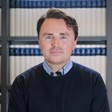
Plastics and the Circular Economy

Vincent Kneefel
15 years: Ocean conservationist
Plastic is great for packing your lunch and paying for products. It’s not so great for marine life. In fact, 11 million tons of plastic ends up in our ocean with 100,000 marine mammals dying annually as a result. How did we get here? Join Vincent Kneefel as he explores why plastics are harmful and how we can reduce the amount in circulation.
Plastic is great for packing your lunch and paying for products. It’s not so great for marine life. In fact, 11 million tons of plastic ends up in our ocean with 100,000 marine mammals dying annually as a result. How did we get here? Join Vincent Kneefel as he explores why plastics are harmful and how we can reduce the amount in circulation.
Subscribe to watch
Access this and all of the content on our platform by signing up for a 7-day free trial.

Plastics and the Circular Economy
14 mins 1 sec
A third of plastic ends up in nature. 11 million metric tons of plastic enters the ocean every year and that number is set to triple by 2040. Plastic has been a dominant material, which has increased in demand since the early 20th century due to its resilience and durability. Yet, 75% of all the plastic ever produced is now waste. Only 9% of the global plastic package is collected for recycling and just 2% is reused as packaging. Vincent encourages firms to use existing solutions and technologies alongside concerted actions to ‘break the plastic wave’.
Key learning objectives:
Understand why plastics are harmful
Learn the negative impacts of plastic
Identify 3 steps to prevent plastic leakage
Define the circular economy
Subscribe to watch
Access this and all of the content on our platform by signing up for a 7-day free trial.
How is plastic impacting the ocean?
- Biodiversity loss: More than 100,000 marine mammals die every year as a result of plastic pollution. According to Oceana, at least 1,800 species are affected by marine debris, from tiny zooplankton, to fish, birds and the largest whales to be harmed through entanglement in or ingestion of plastic
- Climate change: Based on current projections, the production and incineration of plastics will account for 10-13% of the global annual carbon budget
- Human health: Microplastics are contaminating the air we breathe, the food we eat, and the water we drink. Research by Newcastle University has shown that we are ingesting an average of 5 grams of plastic every week, the equivalent of a credit card, coming from "microplastics"
- Tourism: According to WWF an estimated $622 million is lost every year in the Asia-Pacific region alone due to waste and clean-up costs, affecting the livelihoods of communities reliant on tourism
What is the circular economy?
The Ellen MacArthur Foundation has coined the term Circular Economy: a model of production and consumption, which involves sharing, leasing, reusing, repairing, refurbishing and recycling existing materials and products as long as possible. In this way, the life cycle of products is extended. In practice, it implies reducing waste to a minimum. The circular economy is based on three principles, driven by design: eliminate waste and pollution, circulate products and materials (at their highest value), and regenerate nature.
How can the leakage of plastic into the ocean be prevented?
- Reduce the amount of new plastic produced
- Increase the reuse and recycling of plastic already in circulation
- Eliminate leakage of plastic into nature
What will happen if world leaders stay on a ‘business as usual’ path with plastics?
Delaying the actions outlined in Breaking the Plastic Wave by five years would add 80 million metric tons of plastic waste to the 248 million metric tons projected to enter the ocean from 2016 to 2040, compounding risks for local communities and investors.
Subscribe to watch
Access this and all of the content on our platform by signing up for a 7-day free trial.

Vincent Kneefel
There are no available videos from "Vincent Kneefel"






















